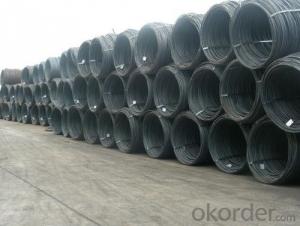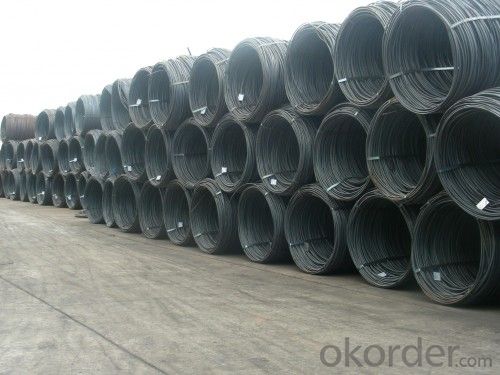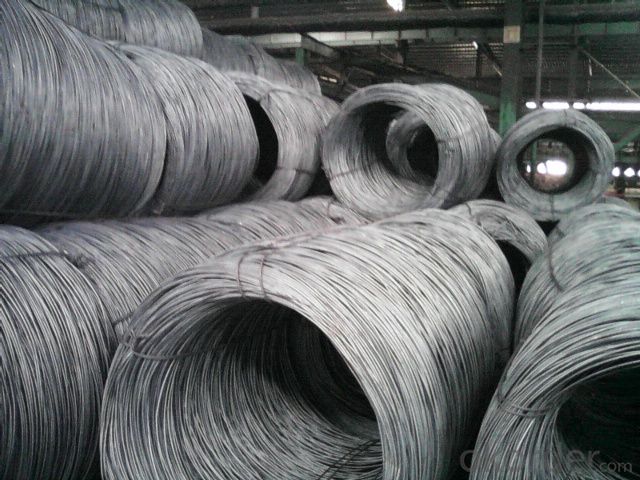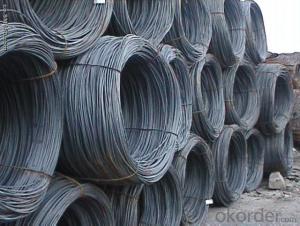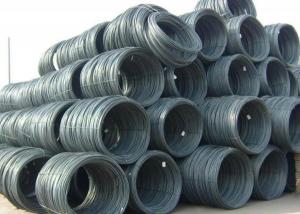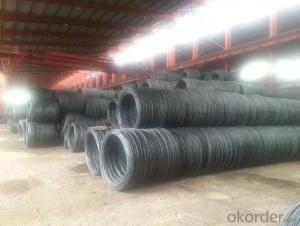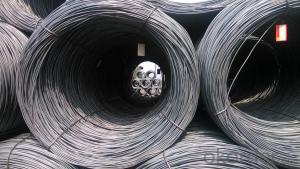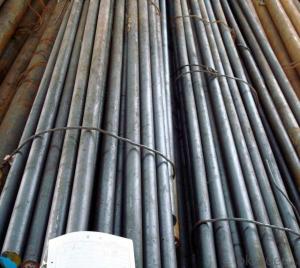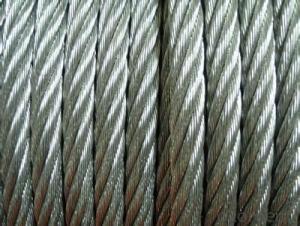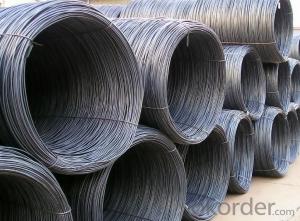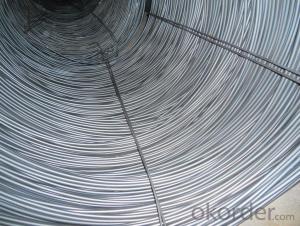HR Steel Wire Rod in Coil
- Loading Port:
- China Main Port
- Payment Terms:
- TT or LC
- Min Order Qty:
- 100 m.t.
- Supply Capability:
- 10000 m.t./month
OKorder Service Pledge
OKorder Financial Service
You Might Also Like
Product Description:
OKorder is offering HR Steel Wire Rod in Coil at great prices with worldwide shipping. Our supplier is a world-class manufacturer of steel, with our products utilized the world over. OKorder annually supplies products to African, South American and Asian markets. We provide quotations within 24 hours of receiving an inquiry and guarantee competitive prices.
Product Applications:
HR Steel Wire Rod in Coil are ideal for structural applications and are widely used in construction and manufacturing. Carbon steel wire rod is mainly used for reinforcement of reinforced concrete and welded structure or reprocessed (roberts , nail, etc.) materials, especially used to produce wire drawing, welding electrode, nails, spring, electronic, precise machinery parts and so on.
Product Advantages:
OKorder's HR Steel Wire Rod in Coil are durable, strong, and wide variety of sizes.
Main Product Features:
· Premium quality
· Prompt delivery & seaworthy packing (30 days after receiving deposit)
· Can be recycled and reused
· Mill test certification
· Professional Service
· Competitive pricing
Product Specifications:
Steel Grade: SAE1006-1018B
Standard: ASTM, GB
Diameter: 5.5mm, 6.5mm, 7mm,8mm,9mm,10mm,12mm,14mm
Type: in coil, coil weight around 2MT
Alloy or Not: Alloy
Technique: Hot Rolled
Place of Origin: China Mainland
Surface: round, no twisted, light and smooth
FAQ:
Q1: How many tons of steel products could be loaded in containers?
A1: Usually the steel products are delivered by bulk vessel because of the large quantity and the freight. However, there are no bulk vessel enter some seaports so that we have to deliver the cargo by containers. The 6m steel product can be loaded in 20FT container, but the quantity is changed according to the size, usually from 18tons to 25tons.
Q2: How do we guarantee the quality of our products?
A2: We have established an advanced quality management system which conducts strict quality tests at every step, from raw materials to the final product. At the same time, we provide extensive follow-up service assurances as required.
Q3: How soon can we receive the product after purchase?
A3: Within three days of placing an order, we will arrange production. The normal sizes with the normal grade can be produced within one month. The specific shipping date is dependent upon international and government factors, the delivery to international main port about 45-60days.
Images:
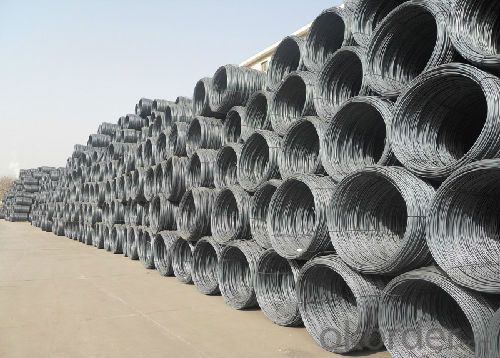
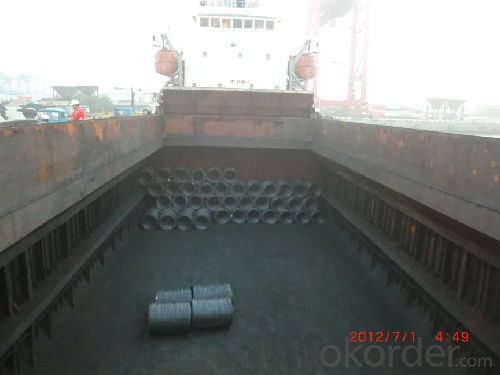
- Q: How is steel wire rod used in the manufacturing of wire for cable harnesses?
- Steel wire rod is a fundamental component in the manufacturing of wire for cable harnesses. The wire rod is initially heated and passed through a series of rolling mills to decrease its diameter and increase its length. This process is called wire drawing. Once the desired wire diameter is achieved, the steel wire rod is coated with a layer of insulation material. This insulation layer acts as a protective barrier, preventing the wire from coming into contact with other wires or conducting materials, thus ensuring safety and preventing electrical short circuits. After the insulation process, the coated wire rod is then further processed to create the specific wire shapes required for cable harnesses. This can include twisting, braiding, or stranding the wire to create cables with different properties and functionalities. The wire rod is also often cut into various lengths to accommodate the specific needs of different cable harness applications. The resulting wire is then used in the assembly of cable harnesses, which are used to organize and secure multiple cables or wires together within a system or device. These cable harnesses are commonly found in various industries, including automotive, aerospace, telecommunications, and electronics. Overall, steel wire rod plays a crucial role in the manufacturing of wire for cable harnesses. It provides the base material for wire drawing, allows for the application of insulation, and is further processed to create the necessary wire shapes. Without steel wire rod, the production of cable harnesses would not be possible, and the efficient organization and safe functioning of electrical systems would be significantly compromised.
- Q: What are the common diameters of steel bars?
- Rebar common diameter 6, 6.5, 8, 12, 14, 16, 18, 20, 22,, 25, 28, and 32.Reinforced concrete (Rebar) is used for reinforced concrete and prestressed reinforced concrete steel, its cross section is round, sometimes with rounded square. Including round steel bar, ribbed steel bar and twisted steel bar.
- Q: How are steel wire rods used in the production of welding electrodes?
- Steel wire rods are essential components in the production of welding electrodes. These wire rods serve as the core material for welding electrodes, providing the necessary strength and conductivity required for the welding process. To begin the production of welding electrodes, steel wire rods are first selected based on their specific mechanical properties, such as tensile strength and elongation. These properties ensure that the welding electrodes will be able to withstand the high temperatures and stress experienced during the welding process. The steel wire rods are then further processed through a series of steps. They are first cleaned and coated with a flux material, which helps to remove impurities and promote better arc stability during welding. This coating also assists in the formation of a protective gas shield around the welding area, preventing oxidation and contamination. After the coating process, the steel wire rods are cut into specific lengths and shaped into the desired electrode design. This can involve bending or forming the rods to achieve the required shape and size of the welding electrode. Once the welding electrode is formed, it is then packaged and made ready for distribution and use. These electrodes are widely used in various industries, including construction, automotive, and manufacturing, for welding applications such as joining metals, repairing machinery, and fabricating structures. In summary, steel wire rods play a crucial role in the production of welding electrodes. They provide the necessary strength, conductivity, and formability required for these electrodes to effectively carry out welding processes.
- Q: How is steel wire rod used in the manufacturing of wire for electrical cables?
- Steel wire rod is a crucial raw material used in the manufacturing of wire for electrical cables. It serves as the base material from which the wire is drawn and formed. The steel wire rod is subjected to a series of processes, including drawing, annealing, and coating, to transform it into a wire with the desired electrical conductivity and strength. This wire is then further processed and insulated to create electrical cables that are widely used in various applications, such as power transmission, telecommunications, and wiring installations.
- Q: What are the common production processes for cobalt-coated steel wire rod?
- The common production processes for cobalt-coated steel wire rod include heating the steel wire rod to a specific temperature, coating it with a layer of cobalt using various methods such as electroplating or hot-dipping, and then cooling and solidifying the cobalt coating. This process helps enhance the corrosion resistance, durability, and overall quality of the steel wire rod.
- Q: How is steel wire rod used in the manufacturing of wire forms for automotive cooling systems?
- Due to its excellent strength and durability properties, steel wire rod is commonly utilized in the production of wire forms for automotive cooling systems. These wire forms are crucial components that provide structural support and help maintain the desired shape and functionality of various cooling system parts. One notable application of steel wire rod in automotive cooling systems is seen in the manufacturing of radiator cores. Radiator cores consist of a network of small tubes and fins that efficiently transfer heat from the engine coolant to the surrounding air. These tubes and fins are often connected and supported by wire forms made from steel wire rod. Steel wire rod is chosen for this purpose due to its high tensile strength, enabling the wire forms to withstand the pressure and vibration experienced in automotive cooling systems. Additionally, steel wire rod exhibits excellent resistance to corrosion, ensuring the wire forms' longevity and reliability even in harsh operating conditions. In the manufacturing process, steel wire rod is initially shaped using specialized machinery. Subsequently, the wire undergoes various heat treatment procedures to enhance its strength and flexibility. Once the wire forms are fabricated, they are integrated into the radiator core assembly, providing support and stability to the tubes and fins. Furthermore, steel wire rod finds use in the production of other wire forms such as hose clamps, brackets, and hooks in automotive cooling systems. These wire forms play vital roles in securing hoses, connecting components, and providing structural support to ensure the proper functioning of the cooling system. Overall, steel wire rod is an indispensable material in the manufacturing of wire forms for automotive cooling systems. Its strength, durability, and corrosion resistance make it an ideal choice for supporting and maintaining the integrity of various cooling system components, ultimately contributing to the efficient operation of the automotive cooling system.
- Q: What are the main factors affecting the market policies of steel wire rod?
- The main factors affecting the market policies of steel wire rod are supply and demand dynamics, global economic conditions, government regulations and policies, technological advancements, and competition in the industry. These factors influence pricing, production levels, trade policies, and market strategies of steel wire rod manufacturers and suppliers.
- Q: What are the different types of steel wire rod testing equipment after wire drawing?
- There are several types of steel wire rod testing equipment that are used after wire drawing to ensure the quality and integrity of the wire. Some of the common types of testing equipment include: 1. Tensile Testing Machine: This equipment is used to measure the tensile strength and elongation of the wire. It applies a pulling force to the wire and measures the resistance and deformation of the wire under load. 2. Hardness Tester: This equipment is used to measure the hardness of the wire. It determines the wire's resistance to indentation or scratching, which is an important factor in determining its suitability for various applications. 3. Surface Roughness Tester: This equipment is used to measure the surface roughness of the wire. It assesses the quality of the wire's surface finish, which is important for applications where smoothness and aesthetics are crucial. 4. Ultrasonic Testing Machine: This equipment uses ultrasonic waves to detect defects or inconsistencies within the wire. It can identify cracks, voids, or other imperfections that may affect the wire's performance or structural integrity. 5. Coating Thickness Gauge: This equipment is used to measure the thickness of any coating applied to the wire. It ensures that the wire has the required coating thickness for corrosion resistance or other protective purposes. 6. Dimensional Measurement Tools: These tools, such as micrometers or calipers, are used to measure the wire's diameter, roundness, and other dimensional characteristics. They ensure that the wire meets the required specifications and tolerances. 7. Chemical Analysis Equipment: This equipment is used to analyze the chemical composition of the wire. It determines the presence and concentration of different elements, alloys, or impurities, which can impact the wire's mechanical properties and suitability for specific applications. These are just a few examples of the various types of steel wire rod testing equipment used after wire drawing. Each type of equipment plays a crucial role in ensuring the quality, performance, and reliability of the wire before it is used in various industries and applications.
- Q: How is steel wire rod used in the manufacturing of wire rope winches?
- Steel wire rod is used in the manufacturing of wire rope winches as the primary material for the wire rope itself. The steel wire rod is first drawn and shaped to form individual wires, which are then twisted or braided together to create the high-strength wire rope. This wire rope is then incorporated into the winch, providing the necessary tensile strength and durability to handle heavy loads and perform lifting or pulling tasks effectively.
- Q: How is steel wire rod stored and protected from corrosion?
- Steel wire rods are typically stored in dry and well-ventilated areas to prevent moisture accumulation, as moisture can accelerate corrosion. They are often kept in stacks or on racks with adequate spacing between each rod to allow for air circulation. Additionally, steel wire rods are protected from corrosion by applying a coating or using corrosion-resistant materials such as galvanized or stainless steel. Regular inspections and maintenance are conducted to ensure the storage conditions are optimal and any signs of corrosion are promptly addressed.
Send your message to us
HR Steel Wire Rod in Coil
- Loading Port:
- China Main Port
- Payment Terms:
- TT or LC
- Min Order Qty:
- 100 m.t.
- Supply Capability:
- 10000 m.t./month
OKorder Service Pledge
OKorder Financial Service
Similar products
Hot products
Hot Searches
Related keywords
